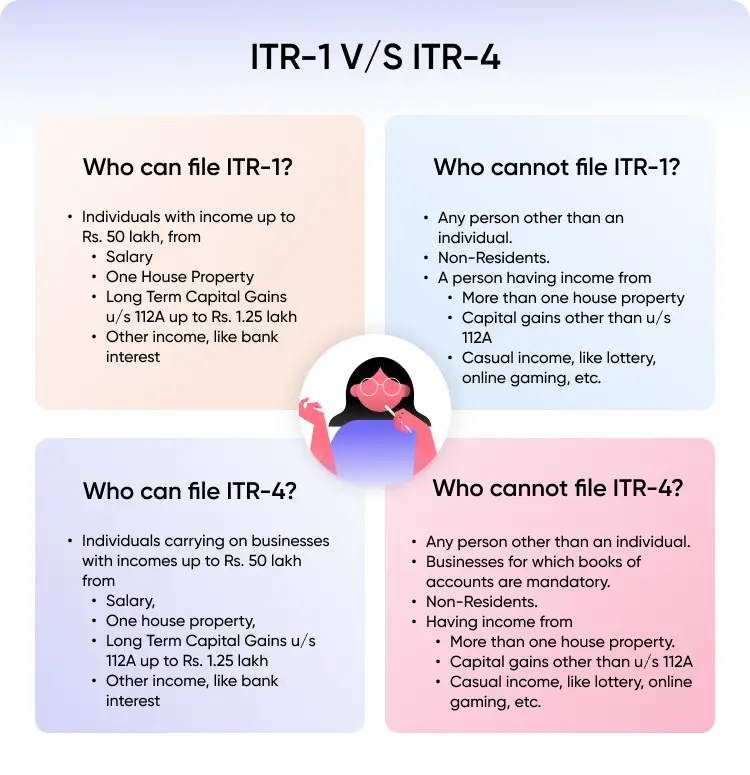
ITR-1 vs ITR-4: Key Differences, Eligibility & Filing Guide for FY 2024-25(AY 2025–26)
ITR-1 (Sahaj) and ITR-4 (Sugam) are the most common forms used by taxpayers, catering to different types of taxpayers and income sources. The key difference between ITR-1 and ITR-4 is that salaried individuals or pensioners file ITR-1, while ITR-4 is filed by individuals with business or professional income opting for the presumptive taxation scheme under sections 44AD, 44ADA, and 44AE.
So, if you are confused between the ITR forms, especially ITR-1 and ITR-4, you can read this article. This article will briefly discuss the forms, helping you understand the key differences between the two.
Link to download ITR-1 and ITR-4 excel based utility

What is ITR-1 (Sahaj)?
ITR-1 or SAHAJ is a type of income tax return filing form meant for resident individuals, and this form includes the Income primarily form:
- Pension or salaries,
- Single-house property
- Other sources (excluding betting, gambling, and lotteries)
- Agricultural Income of up to Rs 5,000
However, this form is eligible for Income up to Rs.50 lacs in the Financial year. Additionally, if the Income of your spouse or minor is clubbed together, you can also file this particular form. Also, individuals with long-term capital gains u/s 112A up to Rs 1.25 lakh are eligible to file ITR-1.
To file ITR-1, you must prepare documents such as Form 16, investment payment premium receipts (if applicable), and house rent receipts (if applicable).
Who Cannot Use ITR-1 Form
- Total income exceeding Rs 50 lakh
- Agricultural income exceeding Rs 5000
- If you have taxable capital gains except long-term capital gains under Section 112A up to Rs. 1.25 lakhs
- If you have income from business or profession
- Having income from more than one house property
- If you are a Director in a company
- If you have had investments in unlisted equity shares at any time during the financial year
- Owning assets (including financial interest in any entity) outside India, including signing authority in any account located outside India
- If you are a resident not ordinarily resident (RNOR) and non-resident
- Having any foreign income
- If tax has been deducted under Section 194N
- If in case payment or deduction of tax has been deferred on ESOP
- If you have any brought forward loss or loss needs to be carried forward under any income head
Still, do you have any doubts about ITR-1 in your mind?
Read our comprehensive guide on ITR-1 to get answers to all your questions.
What is ITR-4 (Sugam)?
ITR-4 or Sugam is another type of ITR form applicable to resident individuals, HUFs, and Partnership Firms (Other than LLPs) generating an income from a business or profession not exceeding Rs 50 lakh. ITR-4 Forms are eligible for the following incomes:
- Salary/Pension
- One House Property
- Agriculture Income up to Rs 5,000
- LTCG under section 112A up to Rs 1.25 Lacs
- Business and Professional income Under presumptive scheme (under Section 44AE, 44ADA and 44ADA of the Income Tax Act, 1961,)
To file ITR-4, you must have the following documents ready: Form 16, Form 16A, Form 26AS and AIS, housing loan interest certificates, rental agreements, bank statements, rent receipts, and receipts for investment premium payments.
Who Cannot Use ITR-4 Form
- If your total income exceeds Rs 50 lakh
- Having income from more than one house property
- Owning any foreign asset
- Having capital gain except long-term capital gain under section 112A exceeding Rs 1.25 lakh
- If you have signing authority in any account located outside India
- Having income from any source outside India
- If you are a Director in a company
- If you have had investments in unlisted equity shares at any time during the financial year
- Being a resident not ordinarily resident (RNOR) and non-resident
- Having foreign income
- If you are assessable in respect of the income of another person in respect of which tax is deducted in the hands of the other person.
- If in case payment or deduction of tax has been deferred on ESOP
- If you have any brought forward loss or loss needs to be carried forward under any income head
Click here to read our comprehensive guide to the ITR-4
What is Difference Between ITR-1 And ITR-4
ITR-1 (Sahaj) and ITR-4 (Sugam) are the most essential income tax returns used by individual taxpayers in India. ITR-1 is meant for individuals with income up to Rs.50 lacs in the financial year for salary, pensions, income from only one owned house property, capital gain under section 112A up to Rs.1.25 lacs and other income, but this ITR does not include income from business or profession, and non-residents are not eligible for ITR-1 (Sahaj). While ITR-4 is for the same source of income under ITR-1 but including business or profession under presumptive scheme (Section 44AD, 44ADA and 44AE.
Both ITR 1 and ITR 4 are the most commonly used forms when it comes to ITR filing. However, from the above piece of information, it is evident that there are some slight differences. For a more comprehensive understanding, take a look at the table given below:
Basis of comparison | ITR-1 | ITR-4 |
Applicability |
|
|
Heads of income |
|
|
When are you not eligible to file this form? |
|
|
Due Date to File Income Tax Return for AY 2025-2026
After knowing about the two types of forms (ITR 1 and ITR 4), it is essential to know about their due dates. The due date to file ITR in the Financial Year 2024-25 (AY 2025-26) is 15th September 2025 for the majority of taxpayers. However, for companies, LLPs, and some individuals who need to get their accounts audited before filing the return, it is 31st October 2025 until further notification by the Central Board of Direct Taxes (CBDT).
Significance of Filing Income Tax Return
The income tax department mandates every earning individual to file ITR. Take a look at some of the reasons why you should not skip filing the applicable ITR:
- Your tax contributes towards nation-building. For instance, in the financial year 2023-24, the Central Government collected Rs 19.60 lakh crore from direct tax payments. Henceforth, the government can utilise this amount for different developmental activities.
- If you wish to apply for a loan, the concerned lender will ask for your income tax return before sanctioning the loan amount.
- In case you have suffered heavy losses from your business or profession, you can carry forward such losses to the next financial year. All you need to do is file your income tax return.
- It permits you to claim your TDS seamlessly. You can adjust your net tax liability using TDS while filing your income tax return for the specified year. If your TDS or advance tax is more than your net tax liability, you can file an ITR to claim a refund.
So, if your gross income is taxable, it is crucial to file the ITR applicable to you. Depending on your income, there are different ITR forms for different individuals; however, the returns filed by most individuals are ITR-1 (SAHAJ) and ITR-4 (SUGAM). Read on to know the key differences between them.
Conclusion
For error-free tax filing, every taxpayer must assess these provisions mentioned above. One of the basic differences between ITR-1 and ITR-4 lies in the presumptive business scheme. This specific provision is applicable to ITR-4 but not ITR-1. At the same time, also ensure to file your ITR within a specified date. If you fail to do so, you will have to pay interest under Section 234A at 1% per month.
Also read about:
1. Which ITR Should I File
2. How to file ITR Online
3. What is ITR 2 Form & How to File ITR-2
4. How to File ITR-2 for Income from Capital Gains FY 2022-23
5. ITR 3 vs ITR 4
6. What is ITR 3 Form & How to File ITR-3
7. How to File and Download ITR-7 Form
8. What is ITR-5 Form, Structure & How to File ITR 5
9. ITR 6
Frequently Asked Questions



